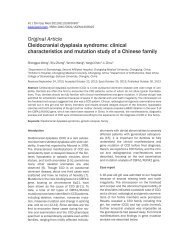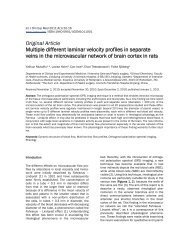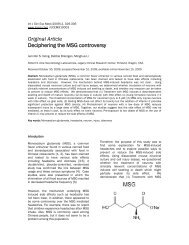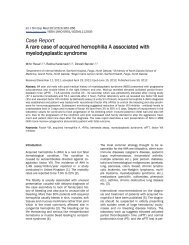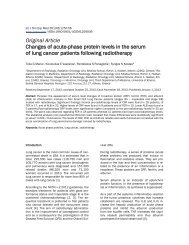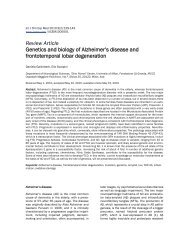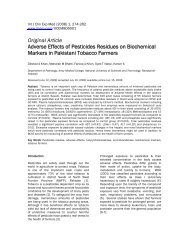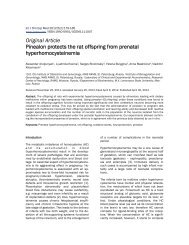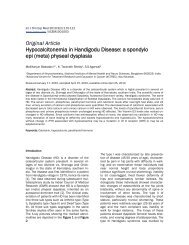Role of myeloid-specific G-protein coupled receptor kinase-2 in sepsis
Role of myeloid-specific G-protein coupled receptor kinase-2 in sepsis
Role of myeloid-specific G-protein coupled receptor kinase-2 in sepsis
You also want an ePaper? Increase the reach of your titles
YUMPU automatically turns print PDFs into web optimized ePapers that Google loves.
Myeloid-<strong>specific</strong> G-<strong>prote<strong>in</strong></strong> <strong>coupled</strong> <strong>receptor</strong> <strong>k<strong>in</strong>ase</strong>-2 <strong>in</strong> <strong>sepsis</strong><br />
Figure 6. Bacterial load <strong>in</strong> various tissue compartments <strong>in</strong> the <strong>myeloid</strong>-<strong>specific</strong> GRK2 knockout and WT littermates<br />
after septic peritonitis: Blood, peritoneal fluid, and various tissue homogenates (collected 18 hours after CLP) were<br />
plated <strong>in</strong> blood agar plates and <strong>in</strong>cubated at 37 C for 24 hours and the number <strong>of</strong> bacterial colonies were counted.<br />
N=10 for WT and N=8 for KO.<br />
ference between the GRK2 wild type and the<br />
GRK2 knockout mice <strong>in</strong> terms <strong>of</strong> the percent <strong>of</strong><br />
macrophages or neutrophils <strong>in</strong>filtrat<strong>in</strong>g <strong>in</strong>to the<br />
peritoneal cavity as assessed by flow cytometry.<br />
Interest<strong>in</strong>gly, however, the expression <strong>of</strong> Ly6G<br />
(as determ<strong>in</strong>ed by mean fluorescence <strong>in</strong>tensity)<br />
but not CD11b was significantly decreased <strong>in</strong><br />
the GRK2 knockout neutrophils (Figure 5).<br />
While Ly6G expression has been associated<br />
with the state <strong>of</strong> neutrophil maturation [34],<br />
how this might expla<strong>in</strong> the exaggerated <strong>in</strong>flammatory<br />
phenotype <strong>of</strong> the GRK2 knockout mice<br />
is not clear. Together, these results suggest that<br />
<strong>myeloid</strong>-<strong>specific</strong> knockout <strong>of</strong> GRK2 does not<br />
regulate the <strong>in</strong>filtration <strong>of</strong> immune cells (total or<br />
differential) <strong>in</strong>to the peritoneal cavity <strong>in</strong> this<br />
model <strong>of</strong> <strong>sepsis</strong>.<br />
Bacterial clearance<br />
An important aspect to the development <strong>of</strong> <strong>sepsis</strong><br />
<strong>in</strong> the CLP model is the clearance <strong>of</strong> bacteria<br />
[31, 32]. Dysregulated clearance <strong>of</strong> bacteria<br />
can lead to excessive bacterial load that will<br />
eventually lead to organ <strong>in</strong>jury and mortality. To<br />
determ<strong>in</strong>e if GRK2 affects clearance <strong>of</strong> bacteria,<br />
we exam<strong>in</strong>ed the bacterial growth from peritoneal<br />
fluid, blood, spleen, lung, liver and mesenteric<br />
lymph node, 18-hours after CLP. As shown<br />
<strong>in</strong> Figure 6, <strong>myeloid</strong>-<strong>specific</strong> knockout <strong>of</strong> GRK2<br />
did not affect the clearance <strong>of</strong> bacteria compared<br />
to the GRK2 wild type mice and showed<br />
similar bacterial loads after surgery.<br />
Mortality after septic peritonitis<br />
Dur<strong>in</strong>g the evolution <strong>of</strong> <strong>sepsis</strong> (after cecal ligation<br />
and puncture), an <strong>in</strong>crease <strong>in</strong> cytok<strong>in</strong>e and<br />
chemok<strong>in</strong>e levels at the local and systemic sites<br />
trigger an <strong>in</strong>crease <strong>in</strong> immune cell <strong>in</strong>filtration<br />
<strong>in</strong>to the local and systemic sites to elim<strong>in</strong>ate the<br />
bacteria [31, 32]. Inappropriate <strong>in</strong>creases <strong>in</strong> the<br />
<strong>in</strong>flammatory cytok<strong>in</strong>es however, can result <strong>in</strong><br />
organ <strong>in</strong>jury and therefore multiple organ dysfunction<br />
[31, 32]. Even though GRK2 knockout<br />
mice had similar bacterial load compared to<br />
that <strong>of</strong> the GRK2 wild type mice, their pro<strong>in</strong>flammatory<br />
status (systemic IL-6:IL-10 ratio)<br />
was exaggerated early after surgery. Therefore,<br />
we reasoned that the multiple organ dysfunc-<br />
325 Int J Cl<strong>in</strong> Exp Med 2011;4(4):320-330



